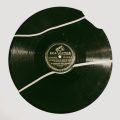Have you sometimes been left wondering about what is the weight of a vinyl record these days? Have you just as often wondered what the weight of a vinyl record might have been in the original era of vinyl technology, how this weight compares to records pressed in the new era of vinyl?
Then you are in the right place, for today we will be exploring precisely these topics, as well as some of hte more logistical questions that arise as a result of the weight of a record and why size and weight supposedly matter in this industry.
Table of Contents

Records Today
The weight of a vinyl record in the industry today can vary wildly from distributor to distributor, so though you may have been hearing the term 180 grams floating around a fair amount with regards to how much a vinyl record weighs, this is not a ubiquitous weight for vinyl records.
The size of a record is the largest dictator of the eventual weight the records weigh. A record collection almost exclusively made up of 7 inch records or 10 inch singles is inherently going to have a lower average record weight than a collection built up of 12 inch records.
For reasons pertaining to sound quality, there is, as previously mentioned, a significant trend toward records produced at 180 grams, a weight which proposes a thicker weight and width, and which is said to subsequently offer deeper grooves within which to imbibe the vibrational data and, thus, better sound quality.
In asking how much does a vinyl weigh, we are forced to ask the parallel question of whether the record weight matter, and (at least in the case made for heavier record 180 gram vinyl pressings) the answer is very much in the affirmative.
Records Yesteryear
Today’s landscape of vinyl production is, however, a rather different story to that of yesteryear, before the wide scale implementation of digital recording and production technology into the musical and home entertainment sphere.
Before this, and before everyone’s vinyl record collection saw the underside of the local trash can, at a time when most records were seeing consistent use, the weight of a record was far from ubiquitous and would vary considerably from pressing to pressing.
There was not really an industry standard, nor was there a precedent for one, and this can be seen in various charts available to see online, which detail just how varied the weight of an average record a few decades ago could be.
Certain audiophiles have taken this kind of research and gone on to weigh their whole record collection so that they might get a whole net spread of data, many finding that the weight considerably varies as well.
This is something you will intuitively feel yourself, even when picking up an old record from a bargain bin or a charity store. The older records tend to be the lighter records, meaning that the heavier records tend to be the newer ones so that all in all you can say that the heavier a record is the more likely it is to be a new one.
However, this is not always the case, for there was such a lack of industry standard in the original vinyl era that the record weight could just as easily find itself in the upper regions, sometimes clocking in at around 200 grams, which almost seems like overkill to our contemporary minds!
Is it better to have an industry standard as we do now so that a consistent level of quality can be assured? Or, is it better that certain recordings are given certain thicknesses of vinyl to accommodate the varied tonal complexity of the music?
Record Oddities
Back in this original vinyl era, just as today, there were salesmen ready to capitalize on the relative popularity of something that seems to wring the popular cultural zeitgeist by the neck.
There were many such gimmicks that flew past the people at high speed, ever churned out to get the attention of the listening public so that they might purchase a certain brand or style of record player over another.
There were, for example, certain children’s books that would include a vinyl record as part of the listening experience, so that it might be listened to alongside the reading or that it might even read the book aloud itself while the child listened and read along.
These records would have made to a considerably lower standard of manufacture, and as a result would likely have been pressed to thinner vinyl, meaning that they would have weighed less overall.
Likewise, similar kinds of records were used by sales people to sell other products. These kinds of records would have been given out for free so that the advertisement cheaply pressed within could be reproduced wherever and whenever.
These pressings would inevitably have been made from thinner vinyl of a lesser quality since they were being manufactured purely for mass distribution of an ideological advertisement. Giving away a bunch of records of thicker vinyl almost seeks to belie the original purpose of giving away the records in the first place, losing whichever company a whole bunch of money as a result.

Why Does it Matter?
There is ever contention over the topic of a record’s overall weight, and yet it can be easy to remove oneself from the argument and ask why the heck it matters.
This is largely the domain of the audiophile, the avid collector and sonic spectrum enthusiast, those who will tell you that the weight of a record is going to vastly and dramatically the sounds imbibed and pressed within the grooves.
This is a matter of much debate, and one that does not entirely have a concrete answer. If you lay out all the information on the table then it makes sense as to why a record’s weight would have such a measurable difference to the overall audio quality.
If the sounds of a record come about as a result of the turntable’s cartridge transmitting the sensitive vibrational data from within the grooves out towards the speakers by means of preamplification, then it stands to reason that the thickness will play a part in the sound.
A thicker record will theoretically encourage thicker and wider grooves, which will mean a bigger and more nuanced sound response as a result, especially when paired with an elliptical stylus.
This is also a matter of shipping, however, especially in this day and age, when a collector is far more like to purchase a record through an online vendor like Discogs than go to their local record store and support a local business.
In this business, the veritable weight of a record is everything, and will greatly affect the total price of shipping for a record as well as the feasibility of transporting a package that contains more than a dozen records. They might not look or feel heavy alone, but their weight adds up!
180 Grams?
Just why are record companies so intent on plugging upon a record’s plastic wrapping that it is pressed onto 180 gram polyvinyl chloride? What are vinyl records made of? And why are audiophiles throwing in their two cents now?
Many will candidly pontificate that a record’s weight has nothing to do with the overall quality of the sound, and if we are take their meaning completely literally then they are not wrong. The weight alone will not have a direct impact on the overall fidelity, though it might have an inadvertent effect on other aspects pertaining to the quality of the sound overall.
An audiophile inversely inclined would have you believe that a thicker record that weighs more is going to sound better. This is, however, not to do with the weight itself, but rather what a thicker disc means for the depth of the grooves.
As previously suggested, if the sounds of a record come about as a result of the turntable’s cartridge transmitting the sensitive vibrational data from within the grooves out towards the speakers by means of preamplification, then it stands to reason that the thickness will play a part in the sound.
If we follow this logic to its natural conclusion, we are left to surmise that a thicker record will theoretically encourage thicker and wider grooves, which will mean a bigger and more nuanced sound response as a result.
The deeper the grooves, the more nuanced and varied the frequency response is likely going to be when paired with a turntable, cartridge, amplifier, and speakers that are willing to put in the work and do the sound justice.
Sometimes, the old debate between CD vs vinyl is a done deal, when a record can offer a listening experience unmarred by the exaggeratedly sequential technology of digital recording which seeks to measure sound in snapshots.
Final Tones
So, there you have it! Hopefully your curiosity around the various questions relatings to the weight of a vinyl record have been somewhat satiated and that you are feeling more knowledgable on the subject as a result, ready and willing to chat to fellow audiophiles and record collectors about precisely these issues, as well as to inspect your own collection for these tell tale signs of pressing plants gone by and eras now caked in the dust of time’s passing.
FAQs
How much do vinyl records weigh in pounds?
If we are to take the broad industry standard these days for vinyl production to be around 180 grams, then we can convert that into pounds pretty easily, leaving us with around 0.4 pounds of record. Not too much at all, right? Certainly, but it sure adds up if you let it, which is precisely what can make transporting a record collection such a tiresome and sometimes impossible feat. Surely all gathered here have seen the backs of vinyl vendors at a local record fair break under the immense pressure of their polyvinly load, born barren for us.
How much does an average vinyl weigh?
Though there is not one ubiquitous weight amongst all records, particularly as there are still two or three vinyl record types that are more or less widely distributed, with regards to 12 inch records, the overwhelming majority are these days produced and pressed onto 180 gram polyvinyl discs. And though this might not seem like much on its own, it can certainly add up, sometimes in an almost miraculous way. Think about picking up even just ten records in one, and their mystical ability to assume a considerable amount more weight than the sum of their parts is exhibited for even the most sceptical to see.
How much does a vinyl record weigh shipping?
This will vary from package to package, particularly as there are two or three major record sizes which are still widely distributed which will vary the weight considerably depending on which size(s) being sent. One of the most important things to remember of how to ship vinyl records is to include the weight of the entire package, including both the product and the packaging. It might not seem like much, but all things have to be weighed and taken into account for the overall price, something that can cause a whole load of hassle at some point along the line. Lord knows I have had to wait a while for certain packages and had to pay more on the other end as a result of this.
How much does a vinyl record weigh grams?
If we are to take the broad industry standard these days for vinyl production to be around 180 grams, then that is around how much a vinyl record will weigh, excusing the sleeve and such. Not too much at all, right? Certainly, but it sure adds up if you let it, which is precisely what can make transporting a record collection such a tiresome and sometimes impossible feat. Surely all gathered here have seen the backs of vinyl vendors at a local record fair break under the immense pressure of their polyvinly load, born barren for us.





